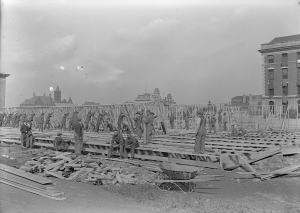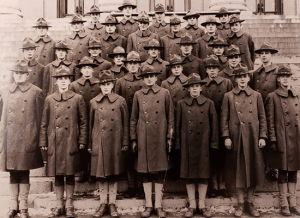In Syracuse University’s history, commitments to veterans and military students can trace back to World War I. SU laid the groundwork for what would evolve into the Reserve Officers Training Corps (ROTC), a pivotal institution that has shaped the lives of countless individuals. This commitment from Syracuse University is what led to the inception of the D’Aniello Institute for Veterans and Military Families, the first interdisciplinary academic institute, singularly focused on advancing the post-service lives of the nation’s military veterans and their families.
During the summer and fall of 1918, Syracuse University answered the call of duty, joining more than 500 colleges and universities in establishing the Students Army Training Corps (SATC). Operating as part of a federal government military training program, the SATC asserted a significant presence on campus. With over 1,200 male students participating, SU transformed Winchell Hall, Archbold Gymnasium, and various fraternity and sorority houses into barracks. Additionally, a substantial mess hall took shape between Sims and Bowne Halls.

Members of the SATC are building a large mess hall between Sims and Bowne Halls
The SATC provided a comprehensive training program, encompassing basic military training alongside classes in auto mechanics, telegraphy, carpentry, surveying, foreign languages, and government. Within this curriculum, there was a dedicated course titled “Issues of the War,” delving into the root causes of the conflict and covering topics relevant to duties in various military branches such as “the infantry, field or heavy artillery, air service, ordnance or quartermaster corps, engineer corps, signal corps, chemical warfare service, motor transport, and truck service.” Military subjects were taught by Army officers, academic subjects were instructed by the faculty of Syracuse University.
The program played a role in shaping the talents for the country. Among these distinguished individuals was SU Chancellor, William Tolley. Graduating from the SATC, Chancellor Tolley became a prominent figure whose influence extended beyond the university walls.

SATC (Future Chancellor Tolley is front, second from left)
Though the Corps was demobilized in December of 1918 due to the Armistice, over a thousand men received invaluable training at SU, laying the foundation for the college’s enduring connection to military education.
In 1919, as the echoes of war gradually faded, Syracuse University pivoted and established the Reserve Officers Training Corps (ROTC). Nowadays ROTC provides a dynamic and diverse training experience every week, equipping cadets with a broad spectrum of skills essential for assuming leadership roles in the military. From engaging in situational training exercises that simulate various offensive operations to mastering land navigation using maps and compasses, cadets develop critical skills. Physical fitness is prioritized through rigorous workouts, ensuring readiness for the Army Physical Fitness Test. Beyond the battlefield, activities like the Combat Water Survival Test, Military Ball, and team-building events foster a well-rounded approach, emphasizing camaraderie and resilience among future Army officers.
From those early days of basic training to the multifaceted classes that have shaped military leaders, SU’s commitment to veterans and military students has stood the test of time.
In forthcoming articles, we’ll delve deeper into pivotal moments from SU’s timeline, unraveling the interconnected web of history that defines the University’s enduring legacy in supporting veterans and military students. Stay tuned for more insights into SU’s remarkable journey.
